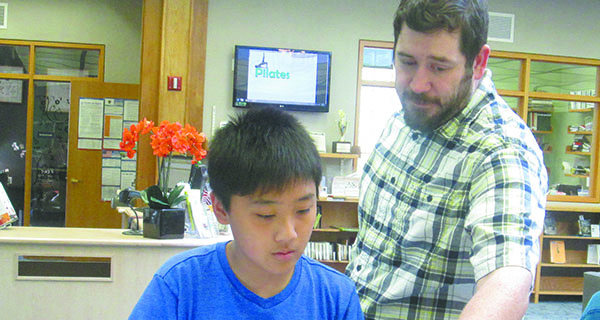[ccfic caption-text format="plaintext"]
By Cameron Small
Hometown Weekly Intern
A large percentage of students would say their parents would kill them if they came home with three D’s. At the Dover Town Library, three D’s is something entirely different thanks to the 3D printer. Every other Thursday at 3:30 p.m., the Dover Library hosts a 3D Printing Workshop.
Granted, “workshop” might not be the best word. It is not a formal sit-down-and-be-told-about-3D-printing sort of event that people might expect. Instead, six or so computers with online CAD software are available for people to come by and design their own 3D item to be printed. Due to the demand, items are not printed right away—alternatively, patrons save their design with their email address and are contacted when their items are printed, usually sometime during the following week.
So long as the dimensions of the design would fit inside the printer, the 3D printer could print it. Jim Westen, the Head of Adult Services at the Dover Library, says the biggest thing he’s printed is “a six inch replica of the Millennium Falcon.” The printing chamber is roughly 10”x6”x8”—though the full printer itself is bigger. The most useful thing Westen has printed is a cellphone holder shaped like a tentacle. Westen has also printed toy boats; elephants with opposable joints at the legs, head, and trunk; interlocked cubes; key chains; and a crown.
As daunting as 3D printing might seem, it isn’t actually that difficult. There are several different CAD software websites that allow users to create 3D objects in the 2D space of a computer. Then the printer recognizes the CAD file and prints it, layering melted plastic to form the object. The object then cools. The printer prints the object at 260˚ C (500˚ F).
There are two types of plastic that can be used, A.B.S (Acrylonitrile butadiene styrene) and P.L.A. (Polylactic acid) The Dover library predominantly uses P.L.A because it is made of more organic materials like corn, thus being better for the environment and not making as much of a typical “melting plastic” smell.
3D printing might seem something out of science fiction, especially considering that medical personnel have used the technology to print prosthetic limbs and organ. But companies like Ultimaker, who made the model of 3D printer at the Dover library, aim to make the 3D printers as ubiquitous to people as toaster ovens. It is because of this goal that the library wants to have workshops to allow people to become familiar with CAD software and 3D printers.
How long the printer takes to print a 3D shape varies on the design, the amount of items being printed, and other factors. During the most recent workshop on July 7, the printer was printing ten toy boats. The printer projected that it would be finished in five hours—approximately a half hour per boat. Generally, the printer takes twenty minutes to a half hour to print.
It doesn’t take too long to get acclimated to the software. Westen estimated that it took him about a week to become proficient with Tinkercad, a basic and free online CAD software. It’s not the software that would print a prosthetic limb, but it is an introduction to the world of 3D printing.
Attendees of the workshops are given toy boats or key chains.























